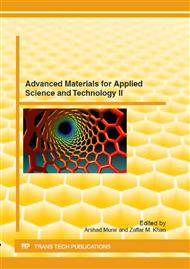p.1
p.9
p.15
p.25
p.37
p.43
p.53
p.63
Prediction of Delamination Crack Growth in Carbon/Fiber Epoxy Composite Laminates Using a Non-Local Cohesive Zone Modeling
Abstract:
The global behavior of composite materials is strongly influenced by the quality of adhesion between different components. A component can be single phase, like fibers or particles used as reinforcement in a homogenous matrix, or a multiphase material like a layer in long-fiber laminate. In the latter case the degradation of adhesion implies the separation of the layers, known as delamination. Among all different failure mechanisms, Delamination is considered to be the most prominent mode of failure in fiber-reinforced laminates as a result of their relatively weak inter-laminar strength. When laminated structures are subjected to static, dynamic or cyclic loadings, the inter-laminar adhesion strength between individual plies tends to deteriorate significantly and act as the origin of the final failure. Therefore, an efficient and reliable design tool capable of predicting delamination could improve the durability for composite laminates. There exist damage mechanics based formulations capable of simulating the delamination crack growth in carbon/glass fiber epoxy based composite laminates. The present study is focused on taking a step forward in this respect. At first, already existed local interface models effectiveness is tested and results are successfully compared with available experimental data for UD IMS/924 Carbon/fiber epoxy composite laminate. Next, a non-local integral-type regularization scheme is introduced to overcome the spurious localization problem associated to the existing local model. Basic concepts and mathematical modeling of Non-Local damage evolution law are comprehensively studied and presented in this study. Finite Element simulation results based on proposed model are discussed in detail and are compared with experimental results.
Info:
Periodical:
Pages:
25-36
Citation:
Online since:
September 2012
Authors:
Price:
Сopyright:
© 2012 Trans Tech Publications Ltd. All Rights Reserved
Share:
Citation:


